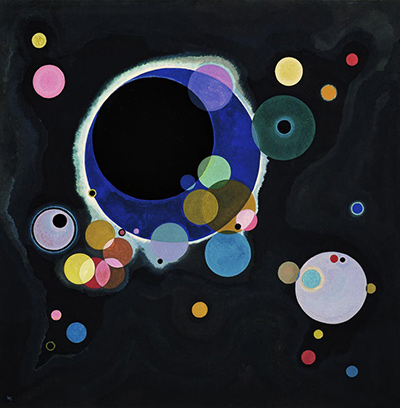Several Circles from Wassily Kandinsky is the perfect example of abstract and spiritual expression on canvas which is proudly homed in the Guggenheim Museum, New York.
The painting is a representation of one form, the circle. The circle as propositioned by Kandinsky is the fusion of the two greatest opposites, that of the concentric and of the eccentric in a single form and in equilibrium.
By limiting Several Circles to only one form, the circle, Kandinsky could focus instead on colour, mass and the relative positions of the circles.
This painting is pure abstract in its truest meaning, it is subjective and relies on the infinite possibilities of interpretation of the circle to create a sense of spiritual and emotional harmony for the viewer.
Several Circles shows of Kandinsky love for the circle, a notable switch from his previous infatuation of horses and a substantial change in direction and purpose compared to his previous body of work.
The painting itself is relatively simple, it is a collection of circles, a lot more than suggested by the title on a black background. The circles are all different sizes and colour. Some of the circles overlap one another, changing their colour. The circles are also positioned in a non-conforming way which would suggest random alignment, however they still seem to be purposeful and deliberate.
At the time Several Circles was created, Kandinsky was interested in scientific encyclopaedias and journals. This interest in the scientific could explain the geometric nature of Several Circles and where it drew it’s influences from. Several Circles is adopted from many different trends including that of the geometrizing trends of Suprematism and Constructivism. Unlike the work of Kandinsky’s peers in 1926, Several Circles is a prime example of Kandinsky’s focus on the expressive content of abstract forms. This focus formed conflict with contemporary artists such as Malevich, Rodchenko and Popova who favoured.
The colours in Several Circles influenced by Goethe’s theory of the emotional effect of colour is a demonstration of the power of colour to directly influence the soul and to have a spiritual effect upon the viewer. Taking influence from Kandinsky’s previous relationship to music, the colours in Several Circles are sounds which are produced when the artist creates vibrations whilst putting oil to canvas. The circle itself is both loud and soft which in Several Circles is both modest and assertive. The idea that colours can influence the emotional and spiritual well-being is well established. Kandinsky championed this view and that different colours have different spiritual values, providing the mutual influence of both form and colour.
Several Circles is more than just a few circles on a canvas though, it is an explosion of colour and translucencies that jump off the canvas into the imagination of the viewer. The circles themselves have depth and weight, they appear to move around the canvas, in and out of focus and bring themselves from the background to the foreground. The painting has only soft lines, however it has depth and drama. The circles move and interact with each other creating a cosmic experience. This painting truly represents Kandinsky’s theoretically spiritual art and is abstract in its truest form.




